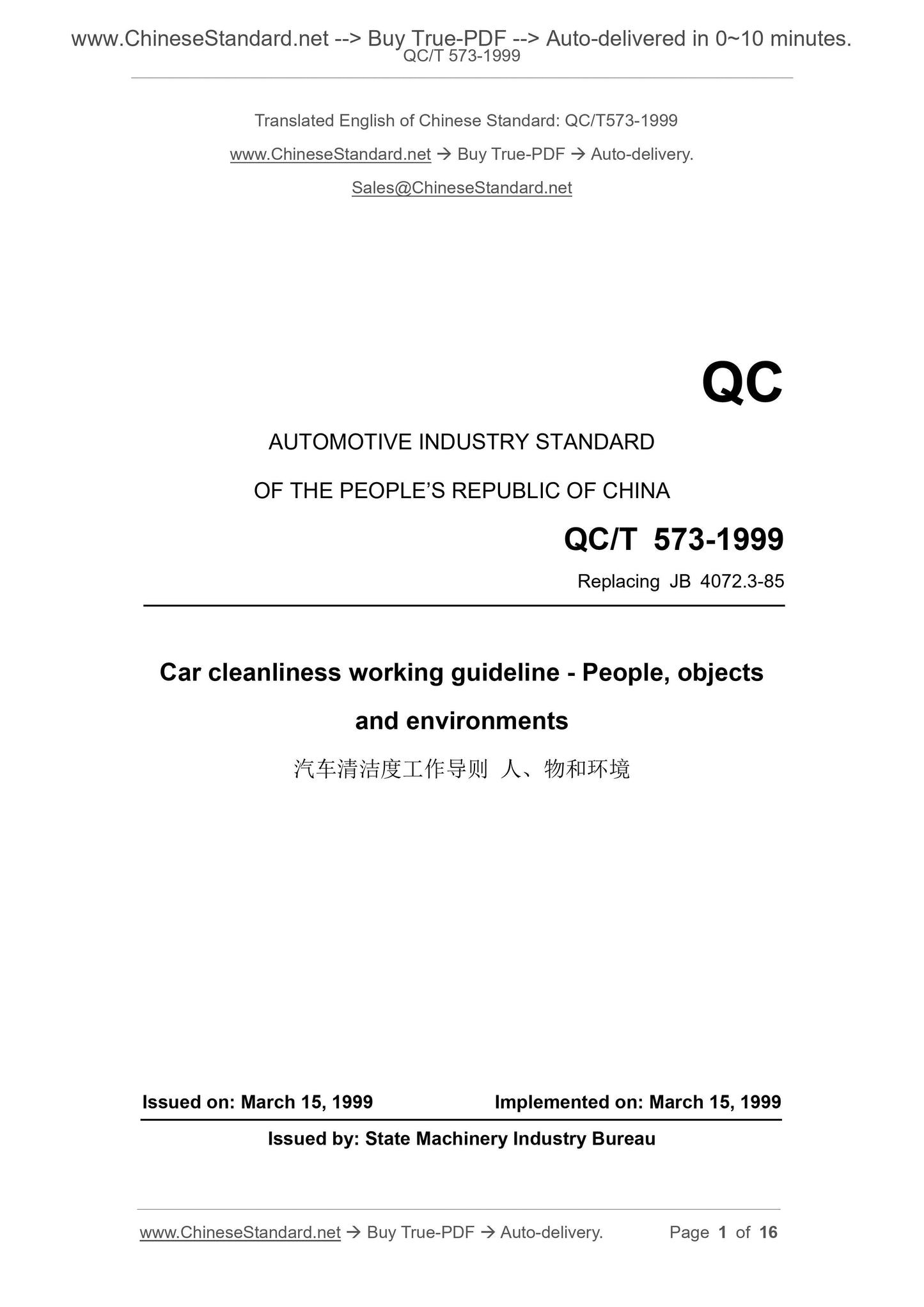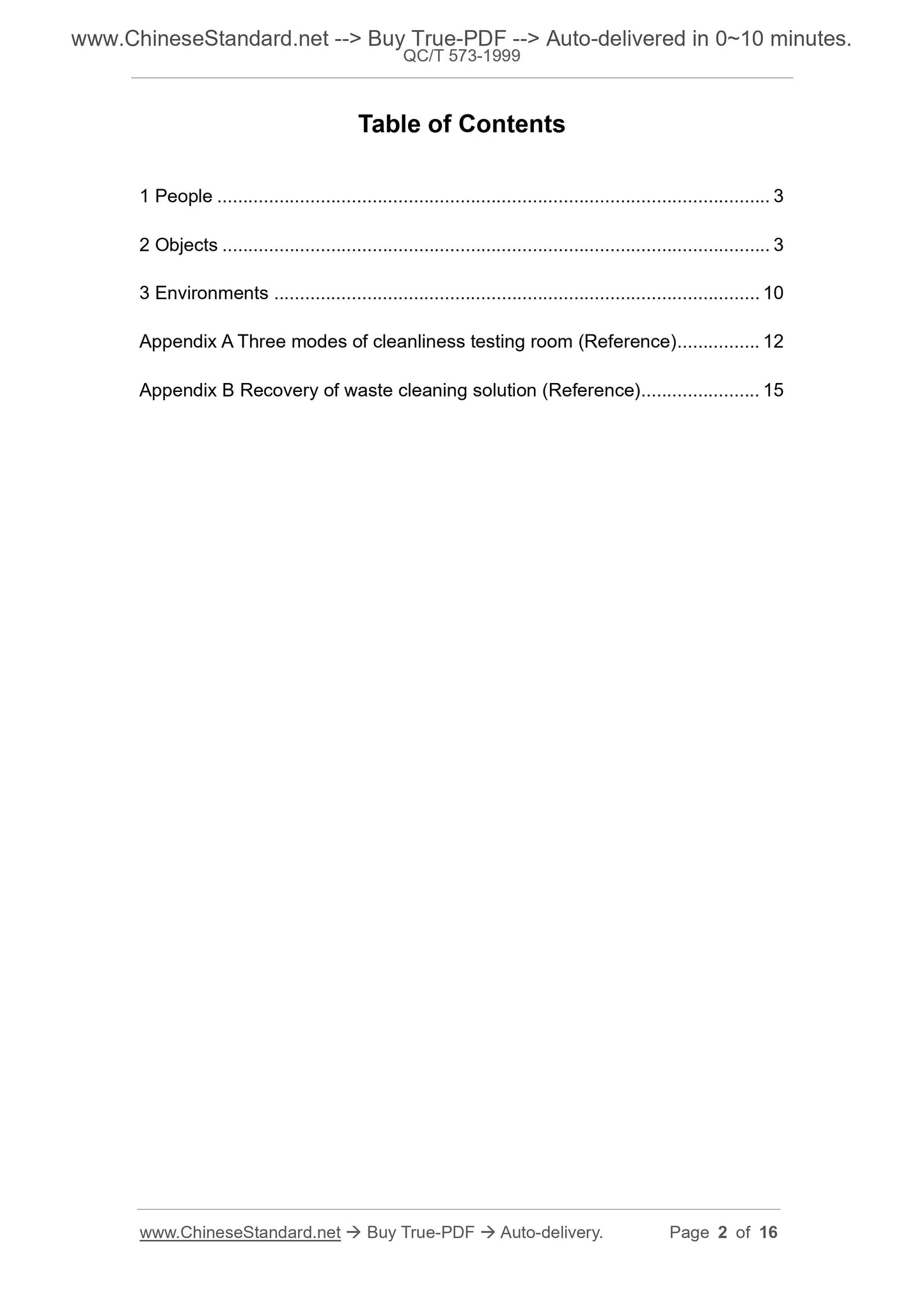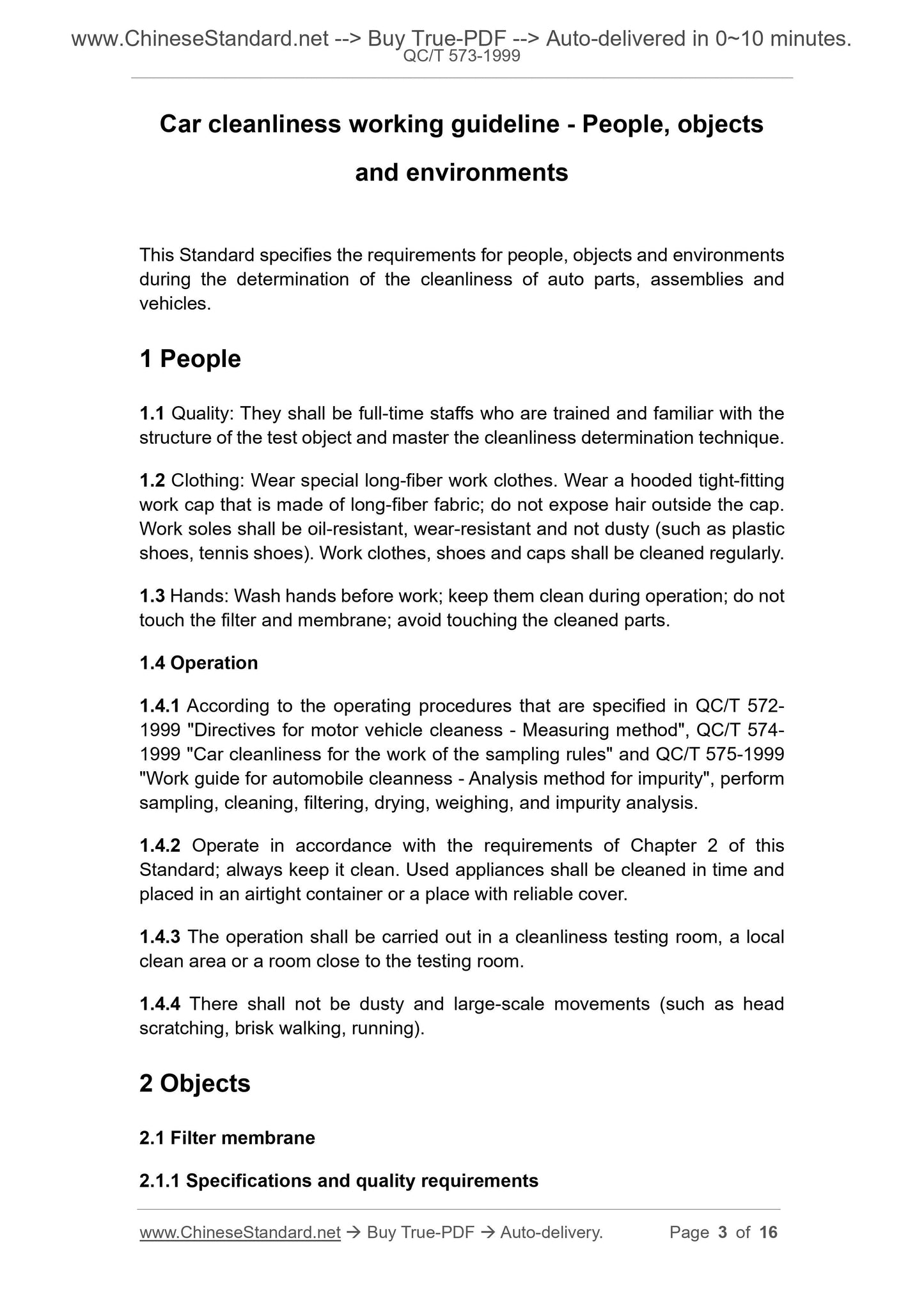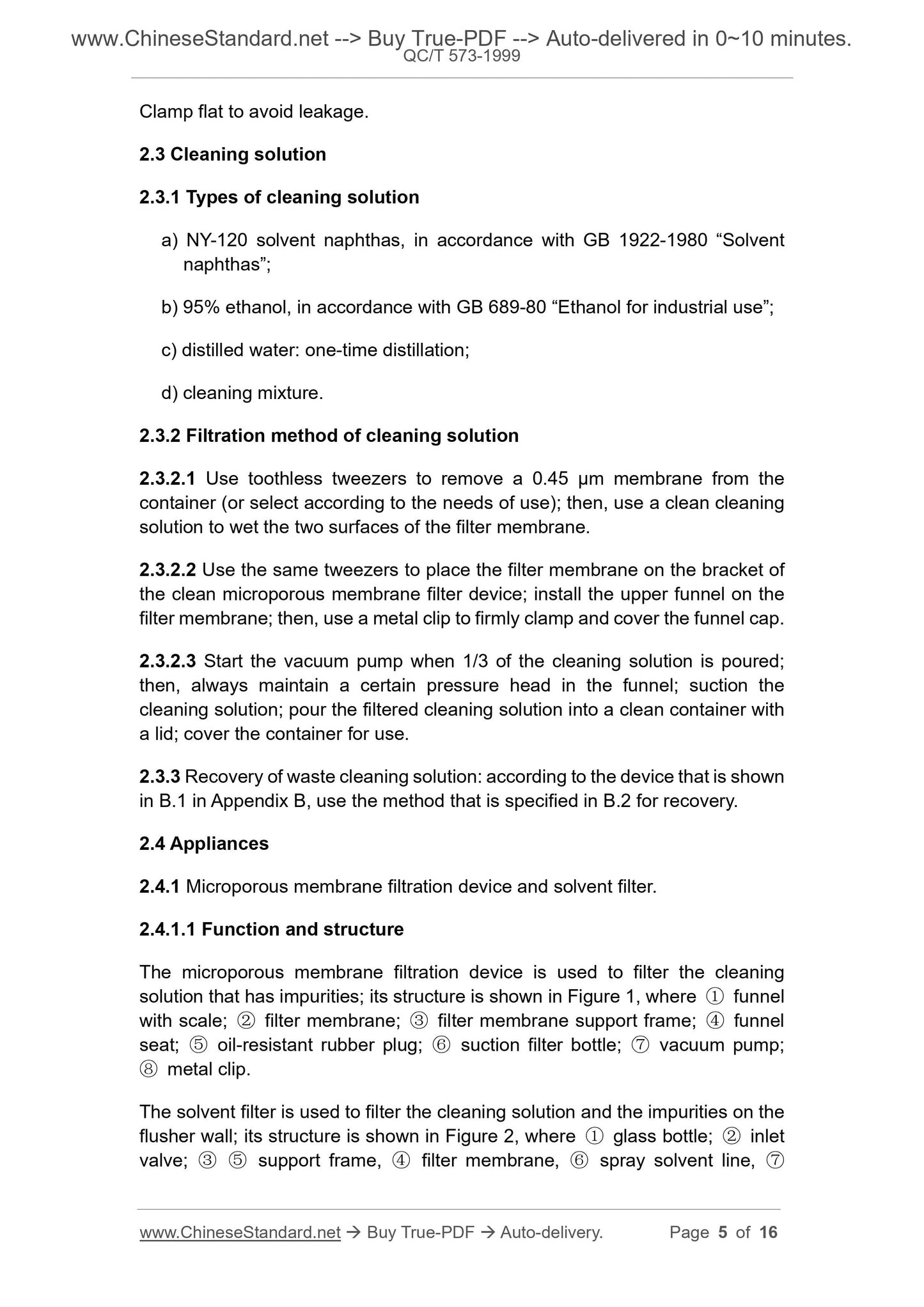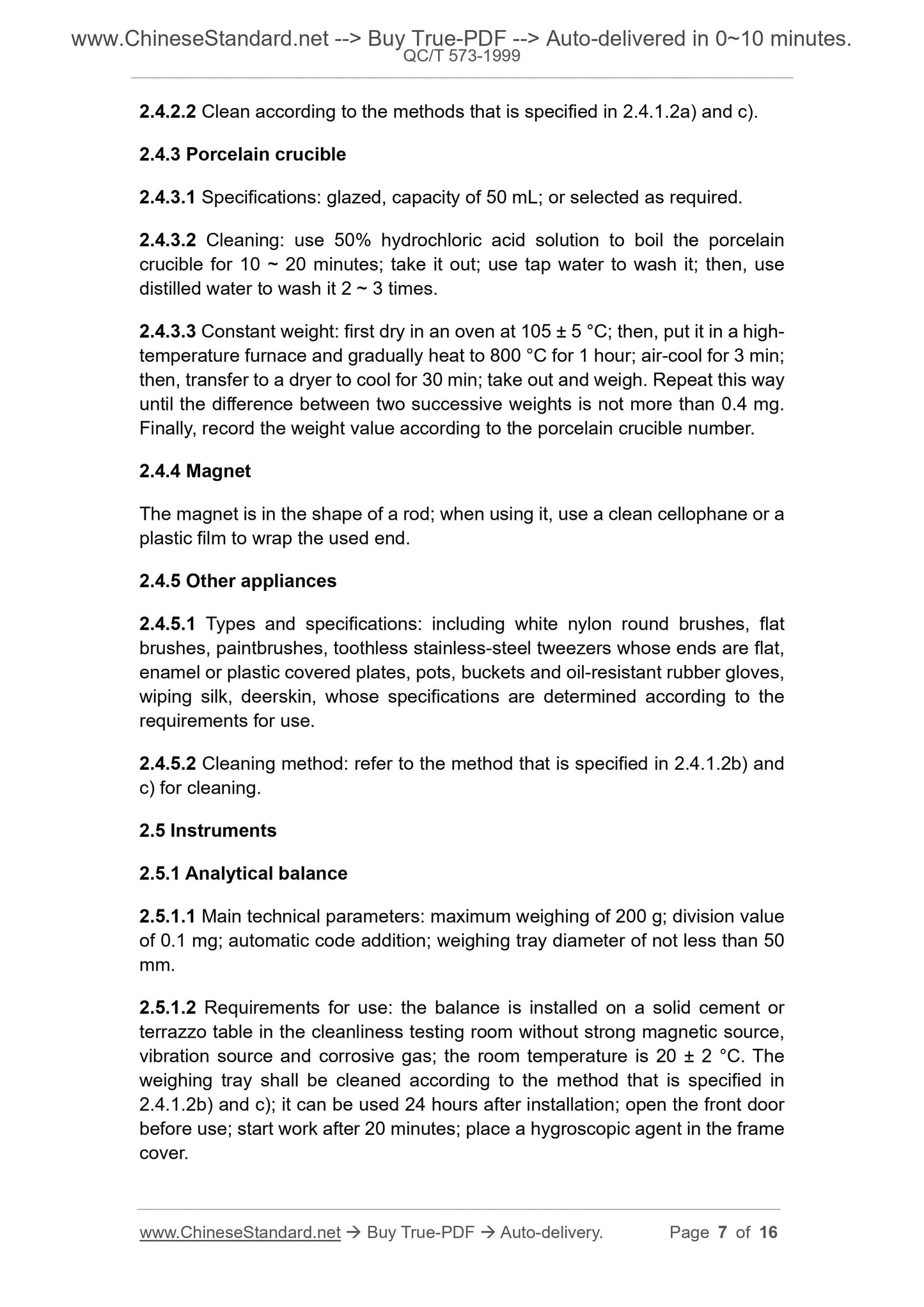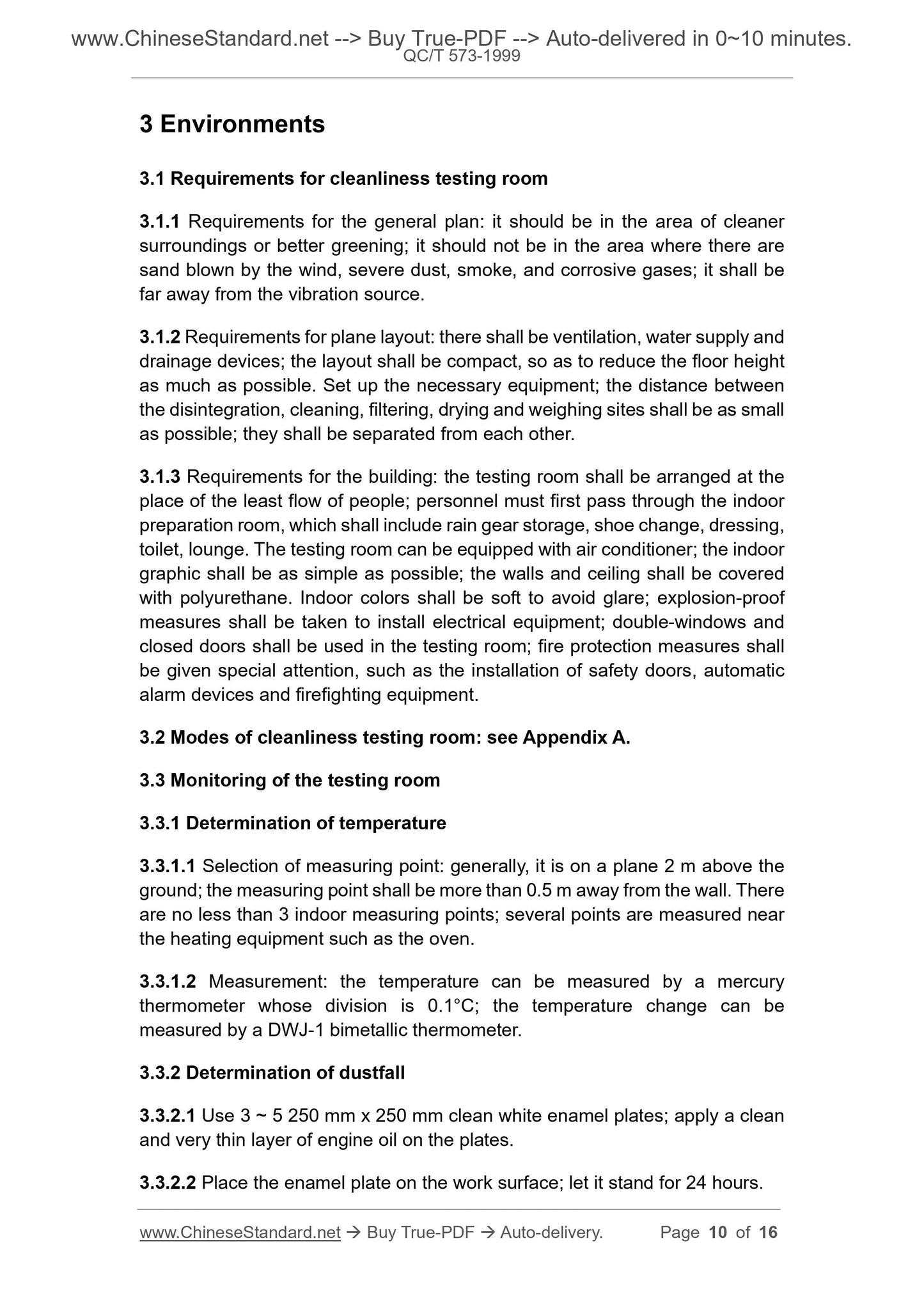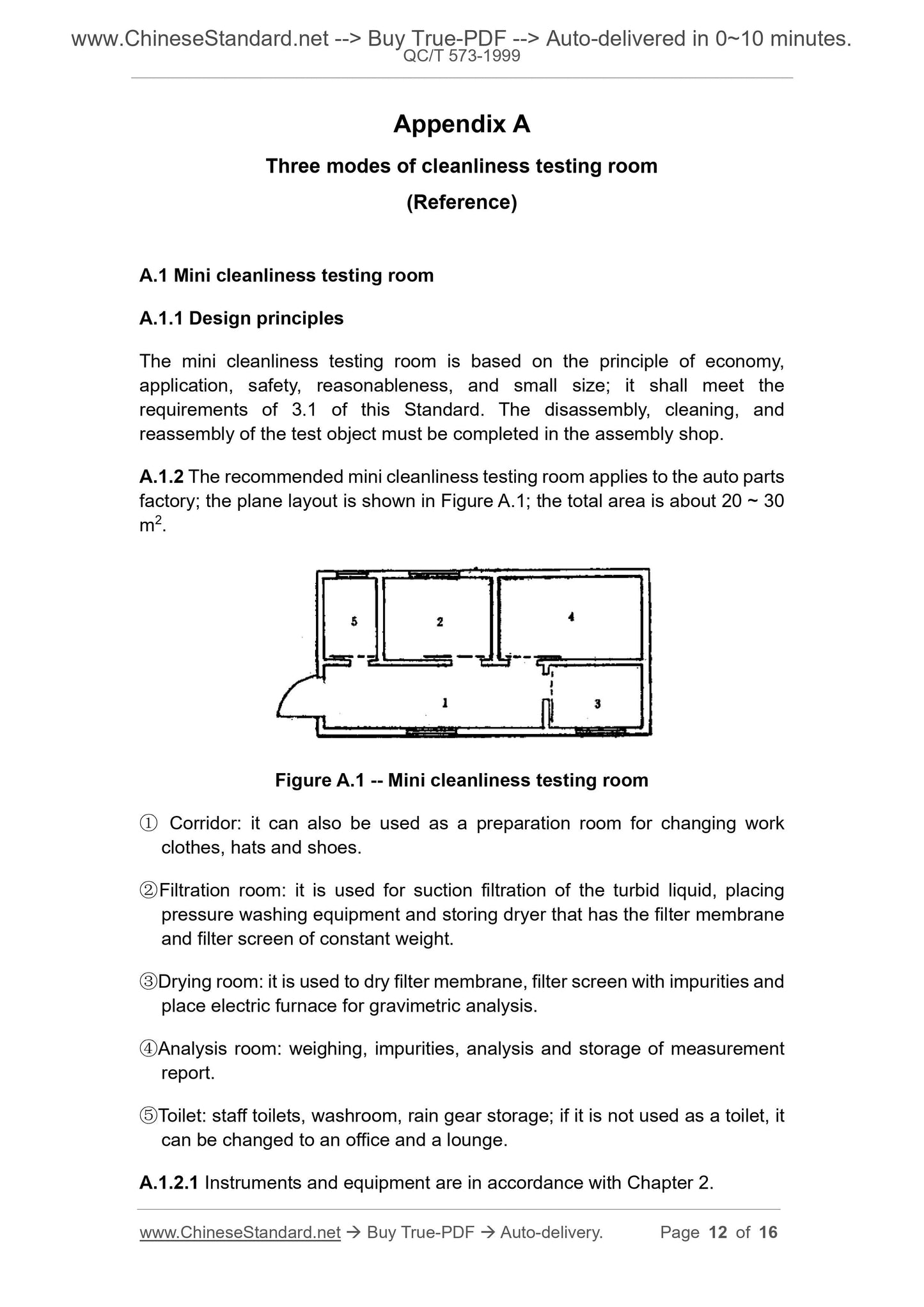1
/
of
7
PayPal, credit cards. Download editable-PDF & invoice in 1 second!
QC/T 573-1999 English PDF (QCT573-1999)
QC/T 573-1999 English PDF (QCT573-1999)
Regular price
$265.00 USD
Regular price
Sale price
$265.00 USD
Unit price
/
per
Shipping calculated at checkout.
Couldn't load pickup availability
Delivery: 3 seconds. Download true-PDF + Invoice.
Get QUOTATION in 1-minute: Click QC/T 573-1999
Historical versions: QC/T 573-1999
Preview True-PDF (Reload/Scroll if blank)
QC/T 573-1999: Car cleanliness working guideline - People, objects and environments
QC/T 573-1999
AUTOMOTIVE INDUSTRY STANDARD
OF THE PEOPLE’S REPUBLIC OF CHINA
Replacing JB 4072.3-85
Car cleanliness working guideline - People, objects
and environments
ISSUED ON: MARCH 15, 1999
IMPLEMENTED ON: MARCH 15, 1999
Issued by: State Machinery Industry Bureau
Table of Contents
1 People ... 3
2 Objects ... 3
3 Environments ... 10
Appendix A Three modes of cleanliness testing room (Reference) ... 12
Appendix B Recovery of waste cleaning solution (Reference) ... 15
Car cleanliness working guideline - People, objects
and environments
This Standard specifies the requirements for people, objects and environments
during the determination of the cleanliness of auto parts, assemblies and
vehicles.
1 People
1.1 Quality: They shall be full-time staffs who are trained and familiar with the
structure of the test object and master the cleanliness determination technique.
1.2 Clothing: Wear special long-fiber work clothes. Wear a hooded tight-fitting
work cap that is made of long-fiber fabric; do not expose hair outside the cap.
Work soles shall be oil-resistant, wear-resistant and not dusty (such as plastic
shoes, tennis shoes). Work clothes, shoes and caps shall be cleaned regularly.
1.3 Hands: Wash hands before work; keep them clean during operation; do not
touch the filter and membrane; avoid touching the cleaned parts.
1.4 Operation
1.4.1 According to the operating procedures that are specified in QC/T 572-
1999 "Directives for motor vehicle cleaness - Measuring method", QC/T 574-
1999 "Car cleanliness for the work of the sampling rules" and QC/T 575-1999
"Work guide for automobile cleanness - Analysis method for impurity", perform
sampling, cleaning, filtering, drying, weighing, and impurity analysis.
1.4.2 Operate in accordance with the requirements of Chapter 2 of this
Standard; always keep it clean. Used appliances shall be cleaned in time and
placed in an airtight container or a place with reliable cover.
1.4.3 The operation shall be carried out in a cleanliness testing room, a local
clean area or a room close to the testing room.
1.4.4 There shall not be dusty and large-scale movements (such as head
scratching, brisk walking, running).
2 Objects
2.1 Filter membrane
2.1.1 Specifications and quality requirements
Clamp flat to avoid leakage.
2.3 Cleaning solution
2.3.1 Types of cleaning solution
a) NY-120 solvent naphthas, in accordance with GB 1922-1980 “Solvent
naphthas”;
b) 95% ethanol, in accordance with GB 689-80 “Ethanol for industrial use”;
c) distilled water: one-time distillation;
d) cleaning mixture.
2.3.2 Filtration method of cleaning solution
2.3.2.1 Use toothless tweezers to remove a 0.45 μm membrane from the
container (or select according to the needs of use); then, use a clean cleaning
solution to wet the two surfaces of the filter membrane.
2.3.2.2 Use the same tweezers to place the filter membrane on the bracket of
the clean microporous membrane filter device; install the upper funnel on the
filter membrane; then, use a metal clip to firmly clamp and cover the funnel cap.
2.3.2.3 Start the vacuum pump when 1/3 of the cleaning solution is poured;
then, always maintain a certain pressure head in the funnel; suction the
cleaning solution; pour the filtered cleaning solution into a clean container with
a lid; cover the container for use.
2.3.3 Recovery of waste cleaning solution: according to the device that is shown
in B.1 in Appendix B, use the method that is specified in B.2 for recovery.
2.4 Appliances
2.4.1 Microporous membrane filtration device and solvent filter.
2.4.1.1 Function and structure
The microporous membrane filtration device is used to filter the cleaning
solution that has impurities; its structure is shown in Figure 1, where ① funnel
with scale; ② filter membrane; ③ filter membrane support frame; ④ funnel
seat; ⑤ oil-resistant rubber plug; ⑥ suction filter bottle; ⑦ vacuum pump;
⑧ metal clip.
The solvent filter is used to filter the cleaning solution and the impurities on the
flusher wall; its structure is shown in Figure 2, where ① glass bottle; ② inlet
valve; ③ ⑤ support frame, ④ filter membrane, ⑥ spray solvent line, ⑦
2.4.2.2 Clean according to the methods that is specified in 2.4.1.2a) and c).
2.4.3 Porcelain crucible
2.4.3.1 Specifications: glazed, capacity of 50 mL; or selected as required.
2.4.3.2 Cleaning: use 50% hydrochloric acid solution to boil the porcelain
crucible for 10 ~ 20 minutes; take it out; use tap water to wash it; then, use
distilled water to wash it 2 ~ 3 times.
2.4.3.3 Constant weight: first dry in an oven at 105 ± 5 °C; then, put it in a high-
temperature furnace and gradually heat to 800 °C for 1 hour; air-cool for 3 min;
then, transfer to a dryer to cool for 30 min; take out and weigh. Repeat this way
until the difference between two successive weights is not more than 0.4 mg.
Finally, record the weight value according to the porcelain crucible number.
2.4.4 Magnet
The magnet is in the shape of a rod; when using it, use a clean cellophane or a
plastic film to wrap the used end.
2.4.5 Other appliances
2.4.5.1 Types and specifications: including white nylon round brushes, flat
brushes, paintbrushes, toothless stainless-steel tweezers whose ends are flat,
enamel or plastic covered plates, pots, buckets and oil-resistant rubber gloves,
wiping silk, deerskin, whose specifications are determined according to the
requirements for use.
2.4.5.2 Cleaning method: refer to the method that is specified in 2.4.1.2b) and
c) for cleaning.
2.5 Instruments
2.5.1 Analytical balance
2.5.1.1 Main technical parameters: maximum weighing of 200 g; division value
of 0.1 mg; automatic code addition; weighing tray diameter of not less than 50
mm.
2.5.1.2 Requirements for use: the balance is installed on a solid cement or
terrazzo table in the cleanliness testing room without strong magnetic source,
vibration source and corrosive gas; the room temperature is 20 ± 2 °C. The
weighing tray shall be cleaned according to the method that is specified in
2.4.1.2b) and c); it can be used 24 hours after installation; open the front door
before use; start work after 20 minutes; place a hygroscopic agent in the frame
cover.
3 Environments
3.1 Requirements for cleanliness testing room
3.1.1 Requirements for the general plan: it should be in the area of cleaner
surroundings or better greening; it should not be in the area where there are
sand blown by the wind, severe dust, smoke, and corrosive gases; it shall be
far away from the vibration source.
3.1.2 Requirements for plane layout: there shall be ventilation, water supply and
drainage devices; the layout shall be compact, so as to reduce the floor height
as much as possible. Set up the necessary equipment; the distance between
the disintegration, cleaning, filtering, drying and weighing sites shall be as small
as possible; they shall be separated from each other.
3.1.3 Requirements for the building: the testing room shall be arranged at the
place of the least flow of people; personnel must first pass through the indoor
preparation room, which shall include rain gear storage, shoe change, dressing,
toilet, lounge. The testing room can be equipped with air conditioner; the indoor
graphic shall be as simple as possible; the walls and ceiling shall be covered
with polyurethane. Indoor colors shall be soft to avoid glare; explosion-proof
measure...
Get QUOTATION in 1-minute: Click QC/T 573-1999
Historical versions: QC/T 573-1999
Preview True-PDF (Reload/Scroll if blank)
QC/T 573-1999: Car cleanliness working guideline - People, objects and environments
QC/T 573-1999
AUTOMOTIVE INDUSTRY STANDARD
OF THE PEOPLE’S REPUBLIC OF CHINA
Replacing JB 4072.3-85
Car cleanliness working guideline - People, objects
and environments
ISSUED ON: MARCH 15, 1999
IMPLEMENTED ON: MARCH 15, 1999
Issued by: State Machinery Industry Bureau
Table of Contents
1 People ... 3
2 Objects ... 3
3 Environments ... 10
Appendix A Three modes of cleanliness testing room (Reference) ... 12
Appendix B Recovery of waste cleaning solution (Reference) ... 15
Car cleanliness working guideline - People, objects
and environments
This Standard specifies the requirements for people, objects and environments
during the determination of the cleanliness of auto parts, assemblies and
vehicles.
1 People
1.1 Quality: They shall be full-time staffs who are trained and familiar with the
structure of the test object and master the cleanliness determination technique.
1.2 Clothing: Wear special long-fiber work clothes. Wear a hooded tight-fitting
work cap that is made of long-fiber fabric; do not expose hair outside the cap.
Work soles shall be oil-resistant, wear-resistant and not dusty (such as plastic
shoes, tennis shoes). Work clothes, shoes and caps shall be cleaned regularly.
1.3 Hands: Wash hands before work; keep them clean during operation; do not
touch the filter and membrane; avoid touching the cleaned parts.
1.4 Operation
1.4.1 According to the operating procedures that are specified in QC/T 572-
1999 "Directives for motor vehicle cleaness - Measuring method", QC/T 574-
1999 "Car cleanliness for the work of the sampling rules" and QC/T 575-1999
"Work guide for automobile cleanness - Analysis method for impurity", perform
sampling, cleaning, filtering, drying, weighing, and impurity analysis.
1.4.2 Operate in accordance with the requirements of Chapter 2 of this
Standard; always keep it clean. Used appliances shall be cleaned in time and
placed in an airtight container or a place with reliable cover.
1.4.3 The operation shall be carried out in a cleanliness testing room, a local
clean area or a room close to the testing room.
1.4.4 There shall not be dusty and large-scale movements (such as head
scratching, brisk walking, running).
2 Objects
2.1 Filter membrane
2.1.1 Specifications and quality requirements
Clamp flat to avoid leakage.
2.3 Cleaning solution
2.3.1 Types of cleaning solution
a) NY-120 solvent naphthas, in accordance with GB 1922-1980 “Solvent
naphthas”;
b) 95% ethanol, in accordance with GB 689-80 “Ethanol for industrial use”;
c) distilled water: one-time distillation;
d) cleaning mixture.
2.3.2 Filtration method of cleaning solution
2.3.2.1 Use toothless tweezers to remove a 0.45 μm membrane from the
container (or select according to the needs of use); then, use a clean cleaning
solution to wet the two surfaces of the filter membrane.
2.3.2.2 Use the same tweezers to place the filter membrane on the bracket of
the clean microporous membrane filter device; install the upper funnel on the
filter membrane; then, use a metal clip to firmly clamp and cover the funnel cap.
2.3.2.3 Start the vacuum pump when 1/3 of the cleaning solution is poured;
then, always maintain a certain pressure head in the funnel; suction the
cleaning solution; pour the filtered cleaning solution into a clean container with
a lid; cover the container for use.
2.3.3 Recovery of waste cleaning solution: according to the device that is shown
in B.1 in Appendix B, use the method that is specified in B.2 for recovery.
2.4 Appliances
2.4.1 Microporous membrane filtration device and solvent filter.
2.4.1.1 Function and structure
The microporous membrane filtration device is used to filter the cleaning
solution that has impurities; its structure is shown in Figure 1, where ① funnel
with scale; ② filter membrane; ③ filter membrane support frame; ④ funnel
seat; ⑤ oil-resistant rubber plug; ⑥ suction filter bottle; ⑦ vacuum pump;
⑧ metal clip.
The solvent filter is used to filter the cleaning solution and the impurities on the
flusher wall; its structure is shown in Figure 2, where ① glass bottle; ② inlet
valve; ③ ⑤ support frame, ④ filter membrane, ⑥ spray solvent line, ⑦
2.4.2.2 Clean according to the methods that is specified in 2.4.1.2a) and c).
2.4.3 Porcelain crucible
2.4.3.1 Specifications: glazed, capacity of 50 mL; or selected as required.
2.4.3.2 Cleaning: use 50% hydrochloric acid solution to boil the porcelain
crucible for 10 ~ 20 minutes; take it out; use tap water to wash it; then, use
distilled water to wash it 2 ~ 3 times.
2.4.3.3 Constant weight: first dry in an oven at 105 ± 5 °C; then, put it in a high-
temperature furnace and gradually heat to 800 °C for 1 hour; air-cool for 3 min;
then, transfer to a dryer to cool for 30 min; take out and weigh. Repeat this way
until the difference between two successive weights is not more than 0.4 mg.
Finally, record the weight value according to the porcelain crucible number.
2.4.4 Magnet
The magnet is in the shape of a rod; when using it, use a clean cellophane or a
plastic film to wrap the used end.
2.4.5 Other appliances
2.4.5.1 Types and specifications: including white nylon round brushes, flat
brushes, paintbrushes, toothless stainless-steel tweezers whose ends are flat,
enamel or plastic covered plates, pots, buckets and oil-resistant rubber gloves,
wiping silk, deerskin, whose specifications are determined according to the
requirements for use.
2.4.5.2 Cleaning method: refer to the method that is specified in 2.4.1.2b) and
c) for cleaning.
2.5 Instruments
2.5.1 Analytical balance
2.5.1.1 Main technical parameters: maximum weighing of 200 g; division value
of 0.1 mg; automatic code addition; weighing tray diameter of not less than 50
mm.
2.5.1.2 Requirements for use: the balance is installed on a solid cement or
terrazzo table in the cleanliness testing room without strong magnetic source,
vibration source and corrosive gas; the room temperature is 20 ± 2 °C. The
weighing tray shall be cleaned according to the method that is specified in
2.4.1.2b) and c); it can be used 24 hours after installation; open the front door
before use; start work after 20 minutes; place a hygroscopic agent in the frame
cover.
3 Environments
3.1 Requirements for cleanliness testing room
3.1.1 Requirements for the general plan: it should be in the area of cleaner
surroundings or better greening; it should not be in the area where there are
sand blown by the wind, severe dust, smoke, and corrosive gases; it shall be
far away from the vibration source.
3.1.2 Requirements for plane layout: there shall be ventilation, water supply and
drainage devices; the layout shall be compact, so as to reduce the floor height
as much as possible. Set up the necessary equipment; the distance between
the disintegration, cleaning, filtering, drying and weighing sites shall be as small
as possible; they shall be separated from each other.
3.1.3 Requirements for the building: the testing room shall be arranged at the
place of the least flow of people; personnel must first pass through the indoor
preparation room, which shall include rain gear storage, shoe change, dressing,
toilet, lounge. The testing room can be equipped with air conditioner; the indoor
graphic shall be as simple as possible; the walls and ceiling shall be covered
with polyurethane. Indoor colors shall be soft to avoid glare; explosion-proof
measure...
Share
